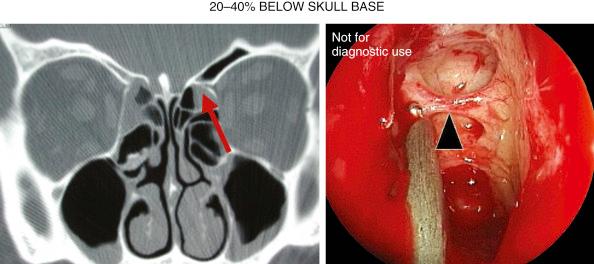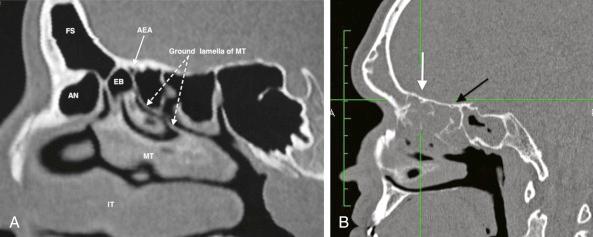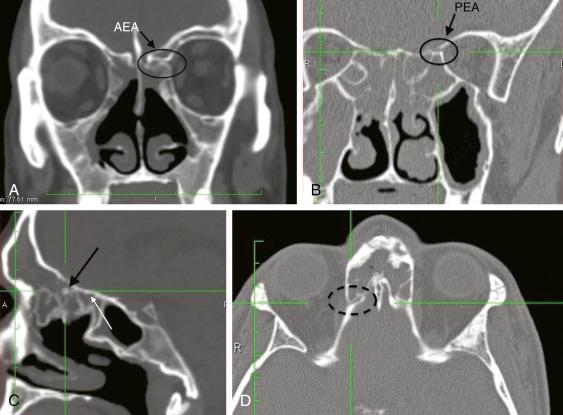Physical Address
304 North Cardinal St.
Dorchester Center, MA 02124
The anterior ethmoid artery (AEA) and the posterior ethmoid artery (PEA) are major vessels supplying the ethmoid sinus, septum, and anterior skull base.
Control of these vessels is a key step in performing extended sinus and skull base procedures.
The critical location of these vessels, which traverse the orbit and roof of the ethmoid sinus, makes iatrogenic damage to these vessels potentially dangerous during endoscopic sinus and skull base surgery ( Fig. 4.1 ).

Retraction of the AEA into the orbit can lead to permanent vision loss if not managed appropriately.
Elective ligation of the AEA and PEA is indicated for extended endonasal procedures when control of these vascular structures is an essential component of the procedure, such as in endoscopic craniofacial resections.
Rarely, intractable or traumatic epistaxis requires ligation of these arteries, but this is probably best managed externally with endoscopic assistance.
This chapter explains how to reliably perform an endoscopic endonasal ligation of the AEA and PEA before surgery of the anterior skull base as well as to perform open arterial ligation for epistaxis.
The AEA and PEA are branches of the ophthalmic artery.
The PEA is smaller than the AEA and is found at the junction of the roof of the sphenoid and posterior ethmoid sinuses.
The AEA lies between the second and third lamella of the lateral nasal wall (ethmoid bulla and middle turbinate, respectively). This is posterior to the anterior face of the ethmoid bulla unless a suprabullar recess exists. In general, it is found one cell behind the frontal ostium along the skull base ( Fig. 4.2 ).

The AEA passes between the superior oblique and medial rectus muscles before leaving the orbit at the anterior ethmoid foramen, together with the anterior ethmoid nerve, to enter the roof of the ethmoid sinus. It crosses the cribriform plate and enters the nose through a tiny slit adjacent to the crista galli to become the dorsal nasal artery.
Depending on the pneumatization of the ethmoid sinuses and the height of the lateral lamella of the cribriform plate, the AEA may lie on a mesentery below the skull base within the ethmoid sinus (seen in 36% of cases; Fig. 4.3 ).

Sixteen percent of AEAs are found to be in a mesentery and dehiscent and therefore at significant risk of traumatic injury in endoscopic sinus surgery.
These arteries also supply the meninges of the anterior cranial fossa and can be considerably enlarged in the presence of meningiomas and other tumors arising in this region.
The crucial external landmark is the frontoethmoid suture line :
The AEA is approximately 24 mm posterior to the anterior lacrimal crest along the frontoethmoid suture line.
The PEA lies approximately 12 mm farther posterior to the AEA along the frontoethmoid suture line.
The optic nerve is approximately 6 mm posterior to the PEA.
Complete exposure of the skull base is required for identification and endoscopic endonasal ligation. Tumor debulking and a complete sphenoethmoidectomy are required to achieve this exposure. The exposure is further aided by an endoscopic modified Lothrop procedure.
For epistaxis, use of an endoscopic approach, which requires significant sinus dissection for exposure and places the skull base at risk, seems unnecessary purely to avoid the small external scar associated with an external incision.
Examine the coronal, parasagittal, and axial computed tomographic scans.
Identify the first coronal scan in which the globe is no longer seen. Look for the protuberance on the lamina papyracea between the superior oblique and medial rectus muscles. This is the anterior ethmoid foramen.
Follow the artery anteriorly to ascertain whether it lies above the skull base in its entirety or whether it descends into the nasal cavity.
Determine whether a suprabullar recess exists. If so, determine whether the AEA lies in front of the anterior face of the ethmoid bulla.
In expanded endonasal procedures, computer-aided surgery is helpful. The images should be reviewed preoperatively to identify the AEA or PEA in each plane and its relationship to the tumor.
0-degree and 30-degree endoscopes
Lens washer (e.g., Endo-Scrub 2 [Medtronic ENT], Jacksonville, Florida)
Routine functional endoscopic sinus surgery instruments (ball-tip probe, microdébrider, straight and angled cutting and grasping instruments)
3.2-mm diamond bur or dacrocystorhinostomy (DCR) bur (Medtronic ENT)
Wormald Suction Bipolar Forceps (Medtronic ENT)
Malleable suction curette (Wormald Malleable Frontal Sinus Surgery Instrument Set [Medtronic ENT])
Vascular clips
For open AEA and PEA ligation, additional instruments include the following:
Scalpel with a No. 15 blade
Freer elevator
Thin, malleable retractors
Standard head and neck bipolar forceps
Endoscopically, the key to finding the AEA and PEA is to define the level of the skull base. This is reliably and safely achieved by identifying the roof of the sphenoid sinus.
Dissect between ethmoid septations that extend from the skull base.
Move the débrider or malleable suction curette in and out between the septations rather than across bony septations from posterior to anterior.
This will clear disease and/or debulk tumor without transecting the AEA or PEA, which might be present in the septation.
The AEA is usually found one cell posterior to the frontal ostium on the skull base.
When performing an ethmoid bullectomy, look for the characteristic posterolateral to anteromedial slant of the AEA in the roof of the ethmoid bulla.
The PEA is identified in the roof of the posterior ethmoid adjacent to the sphenoid.
Even if the artery is in a mesentery, it can be difficult to apply a vascular clip, because the artery is often still encased in bone. The artery therefore must be freed from its bony confines so that a clip can be applied. Alternatively, bipolar forceps can be applied to the exposed component of the artery.
The PEA usually causes minimal problems if accidentally transected, but it can be abnormally large when tumors of the anterior skull base are present or when prior sphenopalatine artery (SPA) ligation has been performed.
Retraction of the AEA behind the orbit can occur if the AEA is accidentally severed, with resultant orbital hematoma. This requires emergency decompression of the orbit.
Refrain from using monopolar cautery to control bleeding from the AEA or PEA. This can result in a bony fracture of the adjacent skull base leading to cerebrospinal fluid leak.
For an open procedure, careful exposure is necessary before cauterization or vascular ligation because the optic nerve lies directly posterior to vessels.
For tumors of the anterior skull base, such as an anterior cranial fossa meningioma, the surgical steps are as described below.
Become a Clinical Tree membership for Full access and enjoy Unlimited articles
If you are a member. Log in here